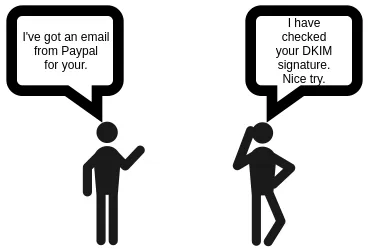Prevent spoofing using DKIM
Email sender spoofing is the act of pretending to be in control of someone else’s email address. This is a common problem with phishing. Often scammers send emails with a sender address of something@paypal.com and hope that the recipient falls for it and trusts them. In fact SMTP does not care which sender address you send. Many mail service providers enforce that you send emails only using your own email address. But some do not. And spammer and scammers obviously could not care less.

So roughly ten years ago a new method was conceived that added a cryptographic signature to the header of an email that the recipient could check to verify the authenticity of the sender and the integrity of the email. The signature is created using a private key that only the sending mail server has. It can then be verified by the recipient by downloading the corresponding public key from the DNS zone of the sending domain and running a signature check. This works very similar to PGP or S/MIME signing – just on a domain level. Your mail server can sign all outgoing emails automatically. The method used nowadays is called Domain Keys Identified Mail – or short: DKIM.
Let’s take an example. I have just sent an email from GMail to my personal email account on my own mail server. Google uses DKIM signing so the email got this additional header from Google’s mail servers:
DKIM-Signature: v=1; a=rsa-sha256; c=relaxed/relaxed; d=gmail.com; s=20161025; h=mime-version:from:date:message-id:subject:to; bh=/FpkZfBuKR0WWcH2fFcr9M4qgX4Z4+/0dX4dpqycK28=; b=fZ4Efy1TuXAl1ho2twkEuNiVP8k5GRKqlol/f/dTawaxciAv1bwinkbu…I need Google’s DKIM public key to verify that signature. It is stored in their DNS zone as a TXT record of “20161025._domainkey.google.com”. The “20161025” is the key selector that is mentioned in the signature as “s=20161025“. You can use any number of keys as long as you create the signatures with the matching private key. The “_domainkey” part is the standard subdomain for DKIM keys. So let’s get that TXT record:
dig +short 20161025._domainkey.google.com txtThis returns…
"k=rsa; p=MIIBIjANBgkqhkiG9w0BAQEFAAOCAQ8AMIIBCgKCAQEAwXNZF1j8sJPDleRjf9SPBNem0ik58kF1ilC1nUgKAttl9v7FX9hXJXPmLNhVtSKVZ8yruaeOZLeIxtgtk1s81zzIE5Mj0AiGn2wlFt4kYfqlDfYe95YLQHjynu4i7vj1Tj" "ksf62btcCbL+3XhbK+oD5PlqYhXHWuzoKoEp5L4lCihgkONvU/oy7NNeE6quqfF/y0YSLwF2WVA2Kd8L6R0Ar2dYT/3wZCFknI7xhvPqh9HNcIWBELGPwtXcsHbX1wvBlCgNQAUcdJrf2YWzAwqmZ564/1ipL1IMk1nafPJk75ktumVNz6ORuIn3jbZWp9rRpnaeI9cu/8KfSKH2EY9QIDAQAB"That is the public key that I can use to verify the signature. An automated check can be done using the “opendkim-testmsg” tool as described later. I can run it and paste the entire email including headers and body into it. If it doesn’t complain with an error message then the signature is correct.
Sounds good? Then let’s implement that for your email domain, too.
Creating a keypair
As explained above you need a private key that your mail server will use and a public key that gets added to your DNS zone. rspamd can create DKIM keys already. You may want to install “dig” though which allows to query DNS records. It works similar to “nslookup” but is more versatile.
apt install dnsutilsrspamd has its built-in DKIM signing module enabled by default.
If you put your key file into /var/lib/rspamd/dkim/ using a certain naming scheme it will pick it up automatically. Create that directory to store keys in:
mkdir /var/lib/rspamd/dkimchown _rspamd:_rspamd /var/lib/rspamd/dkimCreate your keypair:
rspamadm dkim_keygen -d example.org -s 2019122401The selector (-s) I chose is 2019122401 because that’s the day I created it. The first (01) key on 2019-12-24. It doesn’t matter though – you can name it anything you want. If you are lazy and unconcerned you could even use “dkim” as the selector and later spare some work by not needing DKIM maps that define which key is supposed to be used for each domain. “dkim” is the default selector if you do not use maps. But you will probably some day want or need to replace the key so I recommend you rather use maps as explained further below. It gives you more flexibility and is pretty easy to do.
The output will look like this:
-----BEGIN PRIVATE KEY-----MIICdwIBADANBgkqhkiG9w0BAQE…-----END PRIVATE KEY-----2019122401._domainkey IN TXT ( "v=DKIM1; k=rsa; " "p=MIGfMA0GCSqGSIb3DQEBAQUAA4GNADCBiQKBgQCZ8e4RtsvuvsgXyo3Jr63twdx3Zm2RtnYPf87wba5ZnFP0sQIagjJ0R3WL+djKhM5EteBeboTeaflLR+AUKWJdQnL5jzGil+yWThH5C+ixhkdFZPdabkxBji+3r6uRxJKBsN0gy2/+Gp4sGs7lmFgioki9OLgQnzzFh2nE/MSACwIDAQAB" ) ;The first part is the private key. And that includes the “…BEGIN…” and “…END…” lines. This key must be kept secret and will only be used by your mail server to sign outgoing emails.
The second part is the DNS record you need to add to your domain’s DNS zone. Let’s start with that.
Adding the DNS record
Before you start signing your emails you must make sure that the public key is properly present in your DNS zone for the domain you are sending emails from. Otherwise the recipient will be unable to verify the signature and may incorrectly assume that the email was spoofed.
Take a look at the TXT record. It will look something like this:
**2019122401**._domainkey IN TXT ( "v=DKIM1; h=sha256; k=rsa; " "p=MIGfMA0GCSqGSIb3DQEBAQUAA4GNADCBiQKBgQCxenHupkYLPmFMbJjV9dQICKUl2xH/aexSRUwCuw7TJ9dkddqIN+6tyw4VKhnW8R0/UlbzlSFLmVgMU0uUkwTtVqyDHhtSU7LV/SkVYmUst4dTUF1r+8PvhAm7vobMYKdwvRsOq27ABtZc8P4oU2XXHqqa6LU8s4sNxs12hLW9swIDAQAB" ) ;If you are running your own DNS server you should be able to copy this entire file and put it into your DNS zone. However if your internet provider offers you just a web interface to manage your domains then create a new TXT record with a host name of “2019122401._domainkey” in your domain and put the string within the double-quotes into it as the value. In my example:
**2019122401**._domainkey ➠p=MIGfMA0GCSqGSIb3DQEBAQUAA4GNADCBiQKBgQCxenHupkYLPmFMbJjV9dQICKUl2xH/aexSRUwCuw7TJ9dkddqIN+6tyw4VKhnW8R0/UlbzlSFLmVgMU0uUkwTtVqyDHhtSU7LV/SkVYmUst4dTUF1r+8PvhAm7vobMYKdwvRsOq27ABtZc8P4oU2XXHqqa6LU8s4sNxs12hLW9swIDAQABBe aware that the string you got contains two strings “…” + “…” that must be merged into one to work. (The syntax with quotes is meant for a DNS zone file if you run your own name server like bind.) There must usually not be any quotes in the record data. Depending on your ISP it may take a while until the new record is visible on the internet. You can use dig to verify that:
dig +trace **2019122401**._domainkey.example.org txtIf you get the TXT entry like as follows then you are ready to enable DKIM signing in rspamd for that domain:
TXT "p=MIGfMA0GCSqGSIb3DQEBAQUAA4GNADCBiQKBgQCxenHupkYLPmFMbJjV9dQICKUl2xH/aexSRUwCuw7TJ9dkddqIN+6tyw4VKhnW8R0/UlbzlSFLmVgMU0uUkwTtVqyDHhtSU7LV/SkVYmUst4dTUF1r+8PvhAm7vobMYKdwvRsOq27ABtZc8P4oU2XXHqqa6LU8s4sNxs12hLW9swIDAQAB" "" from server foo.bar in 24 ms.Enabling DKIM maps in rspamd
As explained above it is advised to use DKIM maps. It’s nothing fancy. Just a simple file defining which selector you want to use for a certain domain. rspamd will assume that your selector is always “dkim” unless specified otherwise in a map. If you used “dkim” then you may get into trouble when you later want to replace your key. DNS is a sluggish system and propagating a new DKIM public key may take a day. Emails signed with a newer key may get rejected while the DNS record is not yet known everywhere in the world.
Using maps is simple. First we need to change the selector_map setting of the dkim_signing module. To do that create a new file in /etc/rspamd/local.d/dkim_signing.conf and make it contain just these two lines:
path = "/var/lib/rspamd/dkim/$domain.$selector.key";selector_map = "/etc/rspamd/dkim_selectors.map";The configuration is pretty self-explaining. rspamd will look for the domain-to-key mapping in the dkim_selectors.map file. Create that file and make it contain this line:
example.org 2019122401That’s all really. rspamd now knows that whenever it sees an outgoing email from anyone@example.org it will get the DKIM private key from /var/lib/rspamd/dkim/example.org.2018022301.key and use it to sign the email.
Reload the configuration:
systemctl restart rspamdThis method works well if you just have a few domains that virtually never change. If you are rather serving random customer domains you should consider putting the keys into a Redis database instead as described in the documentation. There is not yet a way to manage DKIM keys in a database like MySQL.
Adding the domain key to rspamd
Take the private key that was created earlier (the multi-line string including “…BEGIN PRIVATE KEY…” and “…END PRIVATE KEY…“) and put it into a file at the location where rspamd will look for it:
/var/lib/rspamd/dkim/example.org.2019122401.keyThe name of the file has to be DOMAIN + dot + SELECTOR + “.key” like above. If you name the file incorrectly you will get an error in your rspamd.log file like “lua_dkim_sign_handler: cannot load dkim key /var/lib/rspamd/dkim/example.org.dkim.key“.
Make sure that only _rspamd can read it:
chown _rspamd /var/lib/rspamd/dkim/*chmod u=r,go= /var/lib/rspamd/dkim/*rspamd will automatically pick up the files and does not need to be restarted.
Send a test email
If you have another email account at another location then you could just send a test email there via your mail server. If you take a look at the received email it should have a DKIM header now like:
DKIM-Signature: v=1; a=rsa-sha256; c=relaxed/relaxed; d=example.org; s=**2019122401**; t=1519400838 h=from:subject:date:message-id:to:mime-version:content-type:content-transfer-encoding; bh=kpYel1IlDvqXEUc0SyIpXbMte3XpQOCXHl+zTyHQvGc=; b=NEUyWUoeKE…
To verify the signature install the opendkim-tools package, copy the entire test email (including headers and body), run opendkim-testmsg in your shell and paste the email (finish with CTRL-D).
If you get no output then the signature verified correctly. But if you get something like “opendkim-testmsg: dkim_eom(): Unable to verify” then double-check your DNS record.
You can also use websites like dkimvalidator.com, isnotspam.com or mail-tester.com service to verify that your signatures are working well.
SPF and DMARC
Adding DKIM signatures is a good first step. But you can take it further by telling receiving mail servers that they should not accept any email from your domain without a valid signature or from servers that you do no operate. There are two concepts that aim to help. The older SPF and the newer DMARC. Either of them means creating a machine-readable string in a predefined format and adding a TXT record to your DNS zone. Receiving mail servers can check those records and take your advice (as the domain owner) what to do if the criteria of the email are not met. It could accept the email anyway or flag it as spam or reject it altogether.
Let’s take a look at a typical SPF record:
"v=spf1 ip4:157.97.194.11 mx ~all"What it means:
- this is an SPF record of version 1 of the standard (there is currently no other version)
- please accept emails from the IP address 157.97.194.11
- alternatively accept emails from any server that is mentioned in our domain’s MX record (the server(s) that receive email for your domain)
- any other email should be considered suspicious – it might be spam or worse
There are websites that help you create your SPF string to add to your DNS domain. Keep in mind though:
- You should know which mail servers send email from your domain. Do not forget to include mailing list or newsletter services that send in your name.
- Start with “~all” to mark emails as spam that do not meet the criteria. If all goes well switch to “-all” after a few weeks if you like.
- Note that forwarding emails from your domain may break SPF because suddenly the email appears to be coming from an IP address that is not authorized. This has been a common problem for mailing lists and is gradually being fixed by resending the email from the domain of the mailing list service.
I mentioned that DMARC is the newer standard. So why use SPF anyway? Because some email providers value your effort if you use SPF, too. Technically it’s sufficient to specify a DMARC entry. In my opinion restricting the IP addresses allowed to send is a little dangerous and a little inflexible. It is far more interesting to require that emails from your domain have a valid DKIM signature. Such a record may look like:
"v=DMARC1; p=reject; adkim=s; ruf=postmaster@**example.org**"However to create a proper DMARC entry I suggest you use one of the web sites that aid you there and explain the restrictions and extra features.